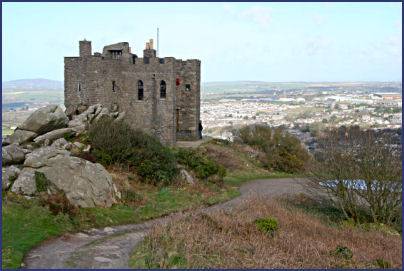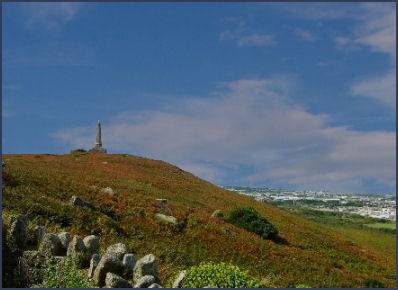Carn Brea Castle
OS Grid ref:- SW 686 408
 Carn Brea Castle, known in Cornish as Karnbre, bestrides a hilltop to the south west of the town of Redruth.
Carn Brea Castle, known in Cornish as Karnbre, bestrides a hilltop to the south west of the town of Redruth.
In Neolithic times, Carn Brea was the site of a large settlement which existed between 3700 and 3400 BC. A two acre inner enclosure was surrounded by a eleven acre outer area. The ramparts consisted of stone walls with an earth bank and ditch. The settlement housed a population of around 100-150 people.
Traces of fourteen platforms on which would once have stood Neolithic long houses have been found by archaeologists within the ramparts. Excavations in 1970-1973 clearly demonstrated that these ramparts, reminiscent of the causewayed camps of lowland England, were Early Neolithic in date (between 4,000 and 3,500 BC)
Pottery and flint artifacts from the period have also been excavated. The site was excavated in 1895 by Thurston Peter. He investigated some of the circular huts inside the ancient settlement, and unearthed many interesting finds. A coin of Macias, King of Namibian in North Africa 148-115 B.C., has been discovered there.
 There is evidence to suggest that the Neolithic ramparts of the hill fort were
partly remodelled during the Iron Age and a collection of stone round houses were built inside during that period. A small number of Roman period finds have been made on the hill, but there is little evidence for further activity until after the Norman Conquest.
There is evidence to suggest that the Neolithic ramparts of the hill fort were
partly remodelled during the Iron Age and a collection of stone round houses were built inside during that period. A small number of Roman period finds have been made on the hill, but there is little evidence for further activity until after the Norman Conquest.
Carn Brea Castle began life a chapel, in 1379, which is thought to be dedicated to St Michael. It has been extensively rebuilt in different periods since, primarily in the eighteenth century by the wealthy Basset family of Tehidy as a hunting lodge, for the surrounding deer park. It is considered a folly castle, due to the huge uncut boulders that make up part of its foundations, giving the impression of the building melting into the land. Since the 1980's the castle has operated as a restaurant.
The 90 feet (30 metre) high granite obelisk which stands by the castle was erected in 1836 to Francis Basset, Lord de Dunstanville and Basset, who petioned the House of Lords against slavery. It was financed by public subscription. The interior of the monument can be accessed by a door and is hollow with a staircase leading up to a viewing platform. The Bassetts where the most important mining family in the area and had lived in Tehidy for over 700 years. Francis Bassett was the first of the family to be raised to the nobility due to his efforts to raise an army of miners to defend the port of Plymouth from the combined Spanish and French fleets.
Image copyright Tony Aitken
Historic Buildings in Cornwall